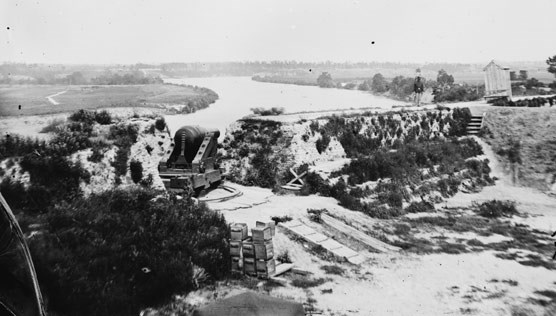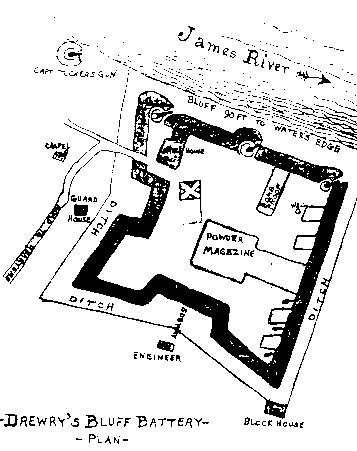
Library of Congress Richmond - Capital of the Confederacy As capital of the newly formed Confederate States of America, Richmond, Virginia, became the constant target of northern armies. During the four years of the Civil War, Union generals made repeated attempts to capture the city by land. Richmond, however, was vulnerable by water as well. Gunboats could navigate the James River all the way to Richmond. The key to the city's river defenses lay in a small fort only seven miles south of the capital. Known throughout the south as Drewry's Bluff, northern troops referred to it as Fort Darling. Drewry's Bluff - Key to the River Defenses Drewry's Bluff, named for local landowner Captain Augustus H. Drewry, rose 90 feet above the water and commanded a sharp bend in the James River, making it a logical site for defensive fortifications. On March 17,1862, the men of Captain Drewry's Southside Artillery arrived at the bluff and began fortifying the area. They constructed earthworks, erected barracks, dug artillery emplacements, and mounted three large seacoast guns (one 10-inch Columbiad and two 8-inch Columbiads) in the fort. On May 9,1862, Norfolk fell to Union forces. The crew of the C.S.S. Virginia, forced to scuttle their vessel to prevent her capture, joined the Southside Artillery at Drewry's Bluff. Commander Ebeneezer Farrand supervised the defenses of the fort. He ordered numerous steamers, schooners, and sloops to be sunk as obstructions in the river beneath the bluff. Six more large guns occupied pits just upriver from the fort. Men worked around the clock to ensure a full state of readiness when the Union fleet arrived. The Federal squadron steamed around the bend in the river below Drewry's Bluff early on the morning of May 15. The force, under Commander John Rodgers, consisted of five ships. The ironclad Galena and gunboats Port Royal, Aroostook, and Naugatuck joined the famous Monitor to comprise Rodgers' force. At 7:15 a.m. the Galena opened fire on the fort, sending three giant projectiles toward the Confederate position. The five Union ships anchored in the river below the fort. When Confederate batteries in the fort replied, the whole vicinity shook with the concussion of the big guns. Southern infantry lined the banks of the river to harass the sailors. On the Monitor, the rifle balls of the sharpshooters "pattered upon the decks like rain." On the bluff the defenders encountered several problems . The 10-inch Columbiad recoiled so violently on its first shot that it broke its carriage and remained out of the fight until near the end. A casemate protecting one of the guns outside the fort collapsed, rendering that piece useless. After four long hours of exchanging fire, the "perfect tornado of shot and shell" ended. With his ammunition nearly depleted, Commander Rodgers gave the signal to discontinue the action at 11:30. His sailors suffered at least 14 dead and 13 wounded, while the Confederates admitted to 7 killed and 8 wounded. A visitor wrote that the Galena "looked like a slaughterhouse" after the battle. The massive fort on Drewry's Bluff had blunted the Union advance just seven miles short of the Confederate capital. Richmond remained safe. Expansion at Drewry's Bluff 1862-1864 Following the repulse of the Union flotilla in May 1862, Drewry's Bluff saw no battle action for two years. Captain Sydney Smith Lee (General Robert E. Lee's brother) took command of the site and supervised its expansion and strengthening into a permanent fort. While some workers constructed an outer line of entrenchments to protect the land approach to Richmond, others built improvements for the fort, including a chapel, barracks, and quarters for the officers. During this time, Drewry's Bluff became an important training ground for the Confederate Naval Academy and the Confederate Marine Corps Camp of Instruction. In May 1864, the fresh threat of an attacking Union force disrupted the daily routine at Drewry's Bluff. Drewry's Bluff in the Bermuda Hundred Campaign, 1864 On May 5, 1864, Union Major General Benjamin F. Butler and his Army of the James landed at Bermuda Hundred, a neck of land only 15 miles south of Richmond. Marching overland, they advanced within three miles of Drewry's Bluff by May 9. While several Union regiments did manage to capture the fort's outer defenses, delays by Union generals spoiled the success. Confederate infantry under General P.G.T. Beauregard seized the initiative and successfully counterattacked on May 16. Once again a Union drive on Richmond met defeat at Drewry's Bluff. The area remained an integral part of Richmond's defense until the fall of Petersburg in April 1865. Drewry's Bluff at the End of the War The garrison at Drewry's Bluff took part in the evacuation of Richmond and Petersburg on April 2-3, 1865. Soldiers, sailors, and marines from the fort joined the movement westward, ultimately surrendering at Appomattox Court House. Many of the sailors served as infantry during the fighting along the way. Union forces quickly cleared a path through the obstructions in the James River beneath Drewry's Bluff. On April 4, 1865, President Abraham Lincoln passed the fort on his way up the James to visit Richmond. 
NPS Eyewitness Accounts We soon began to see that she (the Galena) was being roughly used as shot & shell went crashing through her sides, still she held out & the thunder of her guns pealed out from the sulphurous cloud that enveloped her sending their iron messengers with remarkable accuracy. We could see large clouds of dirt & sand fly as shell after shell from our vessels exploded in the rebel works.... Our experiment with the Galena was fully tried... the Rebels demonstrated fully that she is penetrable. The Galena did most of the fighting-her sides look as though she had an attack of smallpox. Acting as sharpshooters we occupied the banks of the James immediately above the Monitor, Galena, and Naugatuck. These vessels so thoroughly protected their men that we could only pick off one occasionally, but [our] battery did terrible execution. |
Last updated: February 1, 2018
